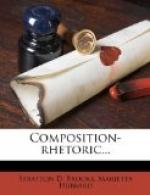1. Point of view. 2. The fireplace. 3. The easy-chair. 4. The table. 5. The bookcase. 6. The cozy nook.
Such an arrangement of paragraphs would give coherence. Unity would be secured by including in each only that which properly belonged to it.
There are many words and expressions which indicate the relative position of objects. The paragraph below is an illustration of the method of development described in Section 47. Notice the words which indicate the location of the different details in the scene. If each of these details should be developed into a paragraph the italicized expressions would serve to introduce these paragraphs and would show the relative positions of the objects described.
The beauty of the sea and shore was almost indescribable: on one side rose Point Loma, grim, gloomy as a fortress wall; before me stretched away to the horizon the ocean with its miles of breakers curling into foam; between the surf and the city, wrapped in its dark blue mantle, lay the sleeping bay; eastward the mingled yellow, red, and white of San Diego’s buildings glistened in the sunlight like a bed of coleus; beyond the city heaved the rolling plains rich in their garb of golden brown, from which rose the distant mountains, tier on tier, wearing the purple veil which Nature here loves oftenest to weave for them; while in the foreground, like a jewel in a brilliant setting, stood the Coronado.
—Stoddard: California.
+Theme XLVII.+—Write a description three or more paragraphs in length.
Suggested subjects:—
1. Some well-known building
(exterior).
2. A prominent person.
3. An attractive room.
4. The interior of a
church.
(Consider your outline with reference to unity, coherence, and proportion of parts. When the theme is completed, consider the unity, coherence, and emphasis of each paragraph and of the composition as a whole.)
+87. Paragraph Relations.+—Relations in thought other than those of time and space may be indicated by the use of certain words and phrases. Such expressions as, however, nevertheless, consequently, indeed, moreover, at all events, etc., are often used to indicate a relation in thought between paragraphs. Notice how nevertheless, at the beginning of the selection below, serves to connect it in thought with a preceding paragraph not printed here. Notice also the relations in thought shown by the italicized words. These and similar words are used to make the transition from one paragraph to the next.




